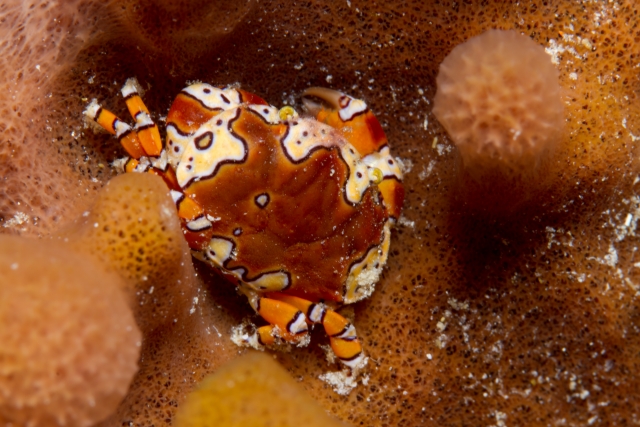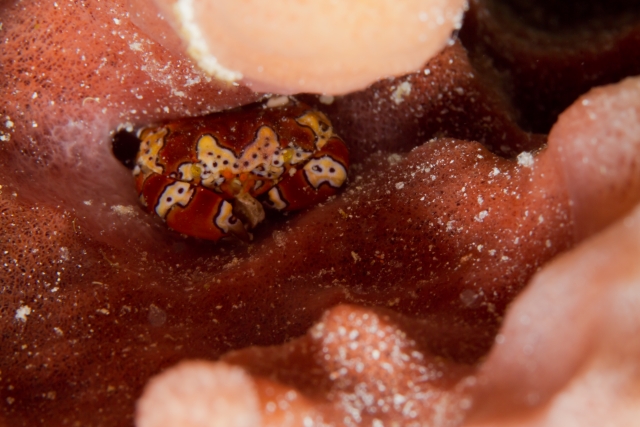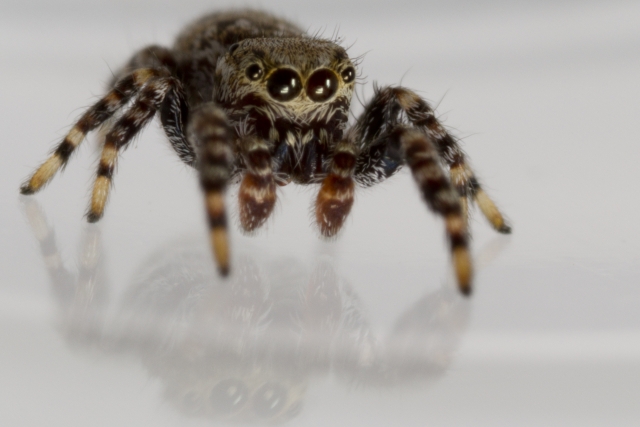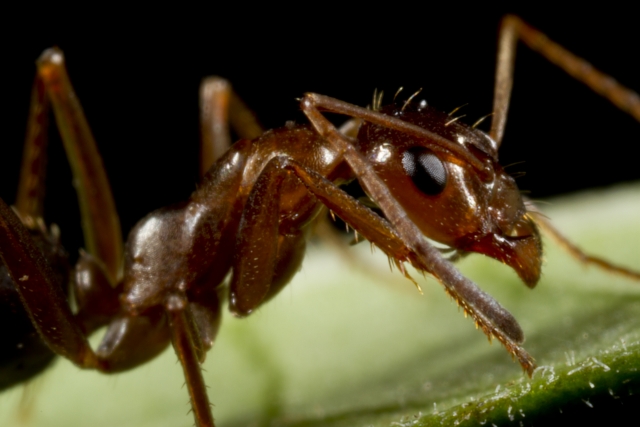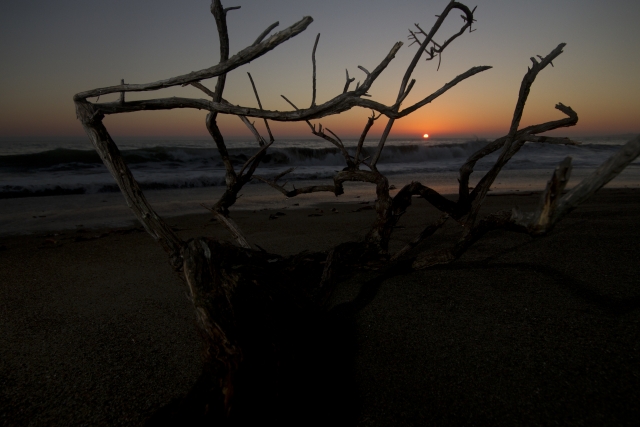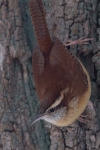flash
Turks and Caicos Explorer: Fluorescing Corals (part 1)
ktuli — Wed, 10/31/2012 - 18:49
What up, fishes!?!
One of the things that I wanted to do on this dive trip was to check out the fluorescence on the reefs. You may have seen some of my land-based results with jumping spiders, but I still was blown away by the results I got.
The equipment I bought was made by NightSea and includes an excitation filter that goes on your light source (flash/strobe) and a yellow lens filter that acts to eliminate the color of the excited light. Basically, the excitation filters produce a bluish light that is the correct wavelength to induce the most common fluorescence responses - the yellow filter then removes that bluish light and returns things back to normal. We also had a special flashlight that had the blue excitation light, plus some yellow filters that went over the front of our masks so we could see the fluorescence effect that way too.
The results were stunning...
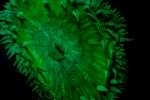 |
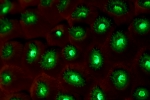 |
 |
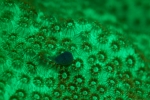 |
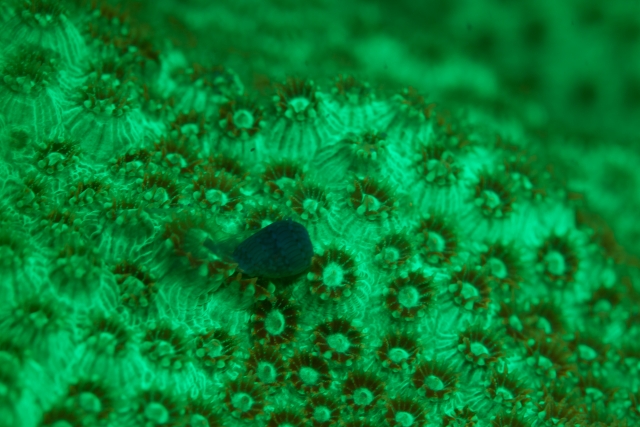 |
|||
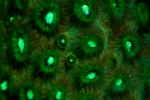 |
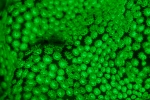 |
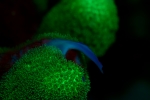 |
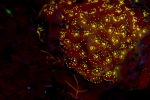 |
Not everything fluoresced on the reefs, so as we shined our lights along the corals, some would glow incredibly bright while others were just black and did nothing. I searched around for small critters like crabs and shrimp, but considering there were always hungry sharks or large horse-eyed jacks feeding during out night dives, it wasn't always the easiest thing to be looking for little stuff while not being able to see anything that wasn't fluorescing.
Maybe next time (and hopefully next time is soon!).
- Bill
Turks and Caicos Explorer: Caribbean Reef Sharks (part 1)
ktuli — Mon, 10/29/2012 - 20:10
Ok - as I hinted at yesterday, I really struggled early in the week.
One of my mistakes was a classic bit of photographer hubris in that I thought I knew enough that adding a new piece of gear to my setup wouldn't be an issue and I'd just pick it up like a fish to water (sorry - terrible pun, I know!). Well, adding a second strobe to my setup certainly was not something I could do without first needing to learn some things - I should have tried out some dry photography with it in the housing and both strobes mounted before going on the trip.
The second issue I had was that there was quite a bit of rust build up. It had been a year since I'd done underwater photography (far too long!), and it took me a while to reacquaint myself with the setup and to remember what settings worked and which didn't. Again, some dry photography might have helped a little, but also just looking at old photos and seeing what worked and what settings were used would have gone a long way.
And the last issue was that despite knowing better, I was using the camera in a way that it just wasn't meant to operated. In particular, with the 100mm macro lens mounted, I certainly could focus on larger subjects that were a ways off, but I really shouldn't have been doing so. I know to reduce the water between me and my subject, and I know the ugly results I get when I fail to do so.
Despite that, and with a liberal amount of Photoshop work, here is my first set of Caribbean Reef Shark (Carcharhinus perezii) from the trip. Hopefully I have better ones to share later...
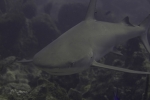 |
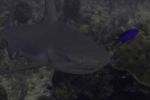 |
 |
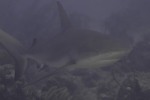 |
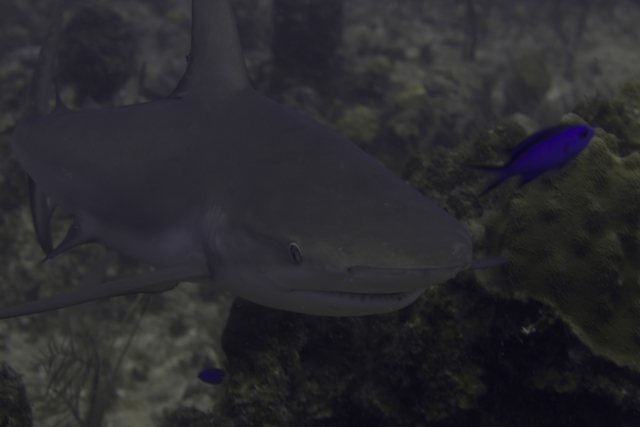 |
|||
Technical Data: Canon EOS 7D, Canon EF 100mm f/2.8L Macro IS USM, 1/200th sec at f/8. Image Stabilization on. ISO 320. Ikelite Housing and Port with dual Ikelite 161 Strobes in TTL Mode. Raw conversion in Photoshop CS5, Color cast removed in Photoshop Elements 9.
I kept these not only because I was able to partially salvage them, but also because I felt these were the first dives we were on where we saw "real" sharks. I know the nurse sharks we've seen before are quite real (and potentially dangerous in the wrong situation - ie: diver stupidity), but these are the first sharks with that classic shark body shape, and they weren't tiny little things... the ones we saw all week ranged in size from 6-10 feet long, and were bulky in weight to match... and fast. Just watching them swim was a treat - being in the water with such a beautiful creature and not being afraid (ok - mostly not afraid) of it was completely incredible.
- Bill
Turks and Caicos Explorer: Gaudy Clown Crab
ktuli — Sun, 10/28/2012 - 20:06
I normally don't like to do this when processing photos, but I've decided to bounce around and pick and choose the order I process the photos from our last dive trip. One reason for this is that I was really struggling early in the week (more on that later), and so to get to the better photos, I have to jump ahead.
Another reason is that I am much more excited to share some of the subjects later in the week. Today's subject is just that.
This is a Gaudy Clown Crab (Platypodiella spectabilis). According to my ID book, these are listed as "occasional", but this is the first one I have ever seen, and when the captain of our boat asked me if I could find it again because he had never managed to get a good photo of one before (not sure if he'd seen one before or not), I felt really pleased with myself for having found it. Keep in mind, they only get to a maximum of 3/4 inch in size...
Technical Data: Canon EOS 7D, Canon EF 100mm f/2.8L Macro IS USM, 1/120th sec at f/16. Image Stabilization on. ISO 100. Ikelite Housing and Port with Ikelite 161 Strobe in TTL Mode. Raw conversion in Photoshop CS5.
So while I felt finding one of these crabs was an accomplishment, I took the challenge to find another on the following dive. I spent the entire dive searching barrel sponge after barrel sponge. And while I'm not 100% sure if this is the same crab or second one (I've tried matching the patterns, and can't come to a decision on it), I am very impressed that I was able to locate one of these crabs for the captain. Unfortunately, as you can see - it wasn't in as good of a location to photograph, so he'll likely have to keep looking... :(
Technical Data: Canon EOS 7D, Canon EF 100mm f/2.8L Macro IS USM, 1/120th sec at f/16. Image Stabilization on. ISO 100. Ikelite Housing and Port with Ikelite 161 Strobe in TTL Mode. Raw conversion in Photoshop CS5.
This is why I love diving... finding these beautiful little creatures that most people have never seen before.... and then doing it again.
- Bill
Reflecting on my Spider Photos
ktuli — Wed, 10/03/2012 - 14:29
I know I've been a bit lax in posting recently. I have been trying to get the gallery system upgraded to the latest version and that has been proving less than simple. On top of that, I've had a backlog of photos to process - today's is one of them.
I recently noticed that at the right angle, the containers I use to catch these jumping spiders in produce a nice soft reflection of the spider. There are some distracting elements (note the while line through the reflection). This shot is a fairly aggressive crop to highlight the spider and reflection while eliminating those distracting elements as much as possible...
Technical Data: Canon EOS 7D, Canon MP-E 65mm f/2.8 1-5x Macro, 1/250 sec at f/13. Canon Macro Twin Lite MT-24EX in ETTL mode. ISO 100. RAW processing and cropped in Adobe Camera Raw.
- Bill
Trashline Spider
ktuli — Wed, 09/26/2012 - 18:27
As the weather gets colder, it will be harder and harder to find spiders... but you know I'll keep looking. We've had one of these interesting spiders living on our shed all summer, so when I saw this one with the nice background, I figured I needed to get a shot of it.
These spiders are called trashline for obvious reasons, and it is used as a form of camouflage - to great effect.
Technical Data: Canon EOS 7D, Canon MP-E 65mm f/2.8 1-5x Macro, 1/25 sec at f/14. Canon Macro Twin Lite MT-24EX in ETTL mode. ISO 1250. RAW processing in Adobe Camera Raw.
The species is Cyclosa conica which is in reference to its cone shaped abdomen, and it is one of the things that actually helps one to spot this spider on its web. As it hides among its 'trash' (which is the remains of its previous meals), it blends in almost perfectly.
Such a cool spider...
- Bill
Super Macro Ant
ktuli — Mon, 09/17/2012 - 20:33
Ok - a brief break from the Yosemite photos (mainly because I need to process more of them) to share a super macro shot I did of an ant during this past week's MeetUp Macro Shootout that I hosted out at South Park...
Technical Data: Canon EOS 7D, Canon MP-E 65mm f/2.8 1-5x Macro, 1/160 sec at f/16. Canon Macro Twin Lite MT-24EX in ETTL mode. ISO 100. RAW processing in Adobe Camera Raw.
Not necessarily a view you get of an ant every day. I normally can't get shots like this because ants rarely hold still, but it was fairly early and somewhat chilly that morning, so this ant was quite sluggish which allowed me to get several shots of it.
- Bill
California Trip: Cambria Sunset
ktuli — Mon, 09/03/2012 - 11:59
Unfortunately, we didn't get any spectacular sunsets during our whole trip...
Technical Data:Canon EOS 7D, Sigma 10-20mm f/4-5.6 EX DC HSM AF at 10mm, 1/250 sec at f/8. ISO 200. Canon Speedlight 580EX II flash in auto mode and wireless control.
I'd found this piece of driftwood earlier in the evening as we strolled along the beach and instantly knew I wanted to use it as a foreground element in a sunset photo. So we (well, mostly Anya) carried it along on our walk until the sun started setting. Unfortunately, the colors of the sunset were pretty muted, and I struggled with getting just the shot I wanted. I knew I wanted to be close to the water, which meant I had to shoot hand-held (plus I'd left my tripod back in the hotel room).
I tried all kinds of combinations - including using the flash remotely to give just a little bit of light to provide some detail on the driftwood. It was far from simple as I was shooting from a very low angle using the live-view on the back of the camera, holding the flash with my left hand to get it far enough away and on a pleasing angle, and of course watching for incoming waves (one of which did end up getting my sandals wet.
In the end, I guess I came away with a couple acceptable shots (of the set, the one above is my personal favorite), and more importantly a good learning experience of things to try or not try in the future.
Here's a few more - both with and without this driftwood...
 |
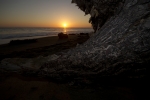 |
 |
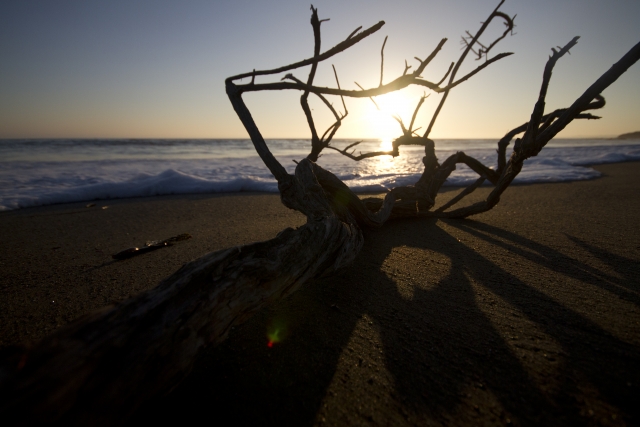 |
||
 |
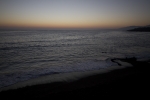 |
 |
I am still making progress through the photos, so hopefully I can get more frequent with the posts. There is still plenty of cool stuff to come....
- Bill
Jumping Spider Super Assortment
ktuli — Thu, 08/09/2012 - 20:45
Too many posts without a spider... so here's a whole assortment to get us caught up... enjoy!
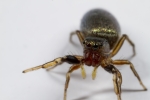 |
 |
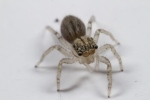 |
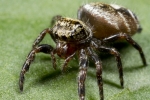 |
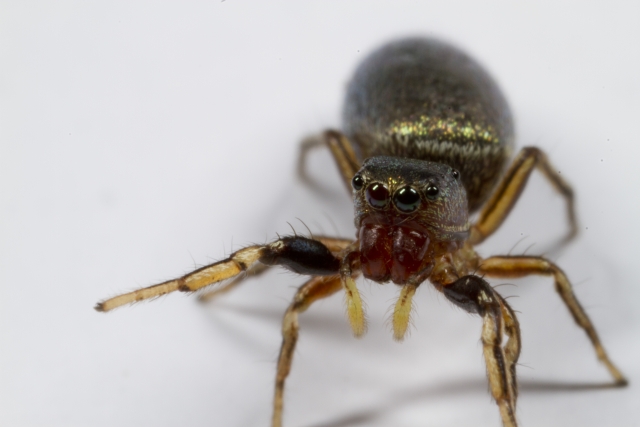 |
|||
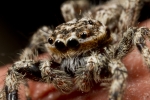 |
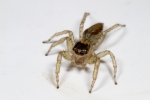 |
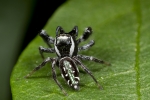 |
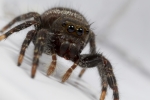 |
There. Now I feel better.
- Bill
Ant-mimic Jumping Spider
ktuli — Tue, 07/31/2012 - 20:07
Ok - normally I would leave a poll up for a little bit longer as the top post, but I just couldn't wait to post this...
Yesterday, on my walk home from work, I found what I believe is an ant-mimic jumping spider Sarinda hentzi). I've been searching for one of these for years - I can't begin to count the number of actual ants that I've given a second glance to to try and find one. As you'll see, it is a wonder I even found this one.
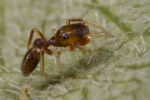 |
 |
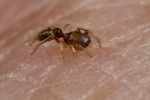 |
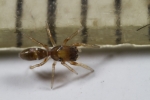 |
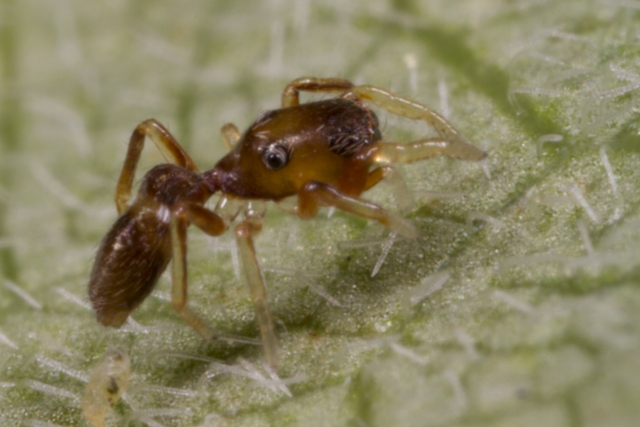 |
|||
 |
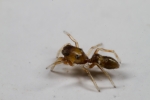 |
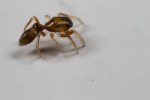 |
 |
Technical Data: Canon EOS 7D, Canon MP-E 65mm f/2.8 1-5x Macro, 1/250 sec at f/16. Canon Macro Twin Lite MT-24EX in ETTL mode. ISO 100. RAW processing and cropped (top left, bottom left) in Adobe Camera Raw.
As you can see from the image in the top right, this little girl (I think it is a female, but I'm not 100% certain) is only 2mm in size. Yes, that is a ruler showing the mm scale that it is climbing on. Adults can grow to between 5-7mm, so this is obviously a juvenile - you can also tell this by the semi-transparent nature of its legs (remember the other spiderlings?). All of these shots were taken at 5x magnification, and the two on the left were cropped even more.
I'm not sure why these little spiders do this mimicry to look like ants, but they do a very good job of it. As you can see in the image on the top left, it will often hold its front two legs up to its head much the way an ant's antenna look. I don't know if this helps them to catch more prey or to be more likely to be ignored by other insects and spiders (ants can usually put up a very good fight and rarely travel alone, so picking on an ant isn't always wise).
Regardless of why, I find this little spider incredibly fascinating, and I am so glad to have been able to finally see one first hand. However, I'm sure this means I will spend many more seconds of my life looking at ants a second time to count how many legs are there... :)
- Bill
Spiderlings Released
ktuli — Thu, 07/26/2012 - 19:55
So my two sets of spiderlings have grown up and were ready to be released. I took a handful of photos of them as they were leaving, and it definitely looks like even spiders have that awkward adolescent stage where they just aren't quite grown into their bodies yet. Check out just how almost comedic these little guys and gals look...
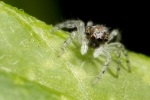 |
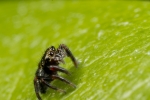 |
 |
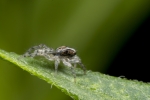 |
 |
|||
Technical Data: Canon EOS 7D, Canon MP-E 65mm f/2.8 1-5x Macro, 1/250 sec at f/16. Canon Macro Twin Lite MT-24EX in ETTL mode. ISO 100. RAW processing in Adobe Camera Raw.
I have a bunch of photos that I've finally gotten through processing, so hopefully I can get some more frequent posts up over the coming weeks.
- Bill

